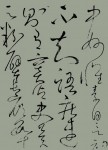Feelings, Dionysus and Cursive Style
Human beings have all kinds of emotions, including happiness, hatred, grief,  desire, love, disgust and fear. The brief emotions such as joy, fury and extreme grief are called passions, while the sustained emotions such as happiness, sorrow, hatred, boredom, admiration and restraint are moods. Both passions and moods affect calligraphic style.
desire, love, disgust and fear. The brief emotions such as joy, fury and extreme grief are called passions, while the sustained emotions such as happiness, sorrow, hatred, boredom, admiration and restraint are moods. Both passions and moods affect calligraphic style.
Emotion falls into two categories: positive and negative. In his Prose of a Brief Account of Oneself , Huai Su, a cursive script master, gives good examples of works written when the calligrapher had positive emotions. Huai Su was a monk who lived during the Tang Dynasty. But he did not follow monastic rules strictly, and was addicted to drink. His work has 126 lines, and is a masterpiece displaying his excellent calligraphic techniques while giving accounts of his life. It quotes verses and sentences by the well-known poets and other famous figures eulogizing his calligraphic techniques, and at the same time illustrates his unconstrained and self-satisfied emotions with romantic and free strokes. The characters are full of life, rhythmand integration. Like a perfect symphony, it stirs the soul of the viewer.
Lu You (1125-1210), a Song Dynasty poet, left 9,300 poems. One of them is titled Ode to Cursive Hand relating his experience in producing a calligraphic work when he was depressed. He was eager to do something for his country, and encouraged people to resist foreign invaders. When he was young, he fought on the war front several times. When he was 57, disillusioned with politics, he retired to his hometown. One of his poems goes, “All my money has gone on three thousand gallons of wine / Yet I cannot overcome my infinite sadness / As I drink today my eyes flash fire / I seize my brush and look round, the whole world shrinks / And in a flash, unwitting, I start to write. / A storm rages in my breast, heaven lends me strength / As when dragons war in the waste, murky, reeking of blood / Or demons topple down crags and the moon turns dark. / At this moment, all sadness is driven from my heart / I pound the couch with a cry, and my cap falls off. / The fine paper of Suzhou and Chengdu will not serve / Instead I write on the thirty-foot wall of my room.” It is pity that this calligraphic work has been lost, as it must have been a dynamic one.
The two calligraphers mentioned above created wonderful works in a cursive or wild cursive script, and expressed their feelings in their works when they were drunk with wine. It is said that wine removes the inhibitions. So when an artist or calligrapher is drunk he ignores common customs and artistic rules, and enters a free and frank realm for creating a work to fully demonstrate his personal characteristics, and tries an artistic style he has never tried before. Now we shall analyze the features of the cursive script. Unlike other scripts, in the cursive script the strokes always are linked together; some are written with a semi-dry brush. The characters are tilted or not, as the calligrapher wishes. The space between the lines is sometimes narrow and sometimes wide. All these irregular rules are a result of the rhythm of the agitation and uneasy feelings of the calligrapher.
The cursive script (especially the wild cursive script) is the most unconstrained among the calligraphic styles, being free from the restrictions of other styles. This can be illustrated by reference to painting. Figure painting is much more restricted than landscape painting. Landscape painting gives more room for the painter to create. The former is like other calligraphic scripts, and the latter is like the cursive script. The cursive script demands a differentiation of written characters, but it is unnecessary to follow the calligraphic rules strictly. Also, the structure of the dots and strokes can be changed. With all these advantages, in the cursive hand the calligrapher can do his best to seek beauty, get all his feelings off his chest and fully demonstrate his calligraphic techniques. Also, among all kinds of calligraphic scripts, the cursive script features the aspect of time. In other scripts, the aspect of time is featured in the movement orientation of strokes and the order of strokes. So the viewers do not see the feature of time, are not interested of the time order. But the feature of time in the cursive script is the result of continuity between two characters or between two strokes. So these features can be seen directly by the viewers, and arouse great interest among them. So, using the visible feature of time, inspired calligraphers move their brushes quickly to express their emotions and feelings.
But we should point out that although calligraphic works can express the feelings of the calligrapher when he moves his brush, he can not express his feelings directly through a certain character, stroke or line because these are not a materialized form of a kind of feeling. That means we cannot say this stroke or line expresses one kind of happiness and that stroke or line expresses sadness. The characters cannot express the calligrapher’s inner feelings, as the characters used in certain poems can.
For the calligrapher, his emotions and feelings can add motion to his creation, and help him to move his brush smoothly. The calligrapher does not try to, and cannot, express or record his concrete feelings. His work displays only the quick rhythm and other changes in the structure of the characters. For the calligrapher, this is enough. He knows quite well that his work refracts his soul in such an obscure language more powerful than spoken language.